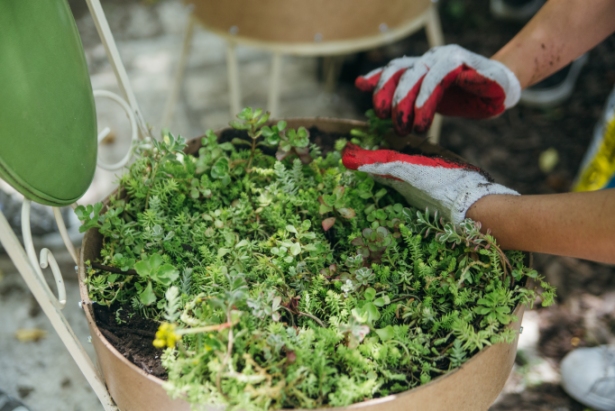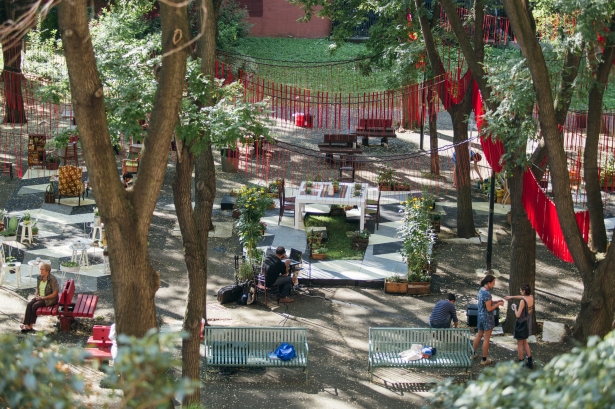This post comes from Creative Carbon Scotland
In July, Creative Carbon Scotland’s Green Arts Manager, Catriona Patterson, attended a research trip hosted by EUROCITIES, and located in Leeuwarden, Friesland in the Netherlands*. There to represent the sustainability work of Edinburgh’s Festivals, and learn most about city-level sustainability-and-culture initiatives, here is her summary of what she learnt.
An Ecologically Sustainable Capital of Culture
Leeuwarden-Friesland began its European Capital of Culture programme in January 2018 and is the host city-region until December this year, having applied and won the opportunity to host the title in 2013 through a competitive bid process. A Capital of Culture year is a European Union-designated initiative, running since 1985, that seeks to celebrate the diversity of the European cultural offering, and which often strengthens the strategic development of cultural in the chosen region. Glasgow was the European Capital of Culture in 1990: a moment which many Scottish arts organisations cite as being transformative to the city and to the cultural scene.
 Capital of Culture programmes are not typically associated with having environmental sustainability as core focus of their work: with socio-cultural and economic generation (or regeneration) being a major motivator for most applying and successful cities. However, the ‘bid’ submitted by Leeuwarden-Friesland back in 2013 also included a significant environmental sustainability component, and it was exploring this which was the focus of my trip.
Capital of Culture programmes are not typically associated with having environmental sustainability as core focus of their work: with socio-cultural and economic generation (or regeneration) being a major motivator for most applying and successful cities. However, the ‘bid’ submitted by Leeuwarden-Friesland back in 2013 also included a significant environmental sustainability component, and it was exploring this which was the focus of my trip.
Recognising the link between physical environmental surrounds, and the ways of life that exist within them, ‘Nature and Culture’ is one of three key themes for the year’s programme (alongside ‘City and Countryside’ and ‘Community and Diversity’):
“Nature and Culture in Europe: biodiversity and geo-diversity are under threat. This affects cultural diversity, too. Culture and nature are living organisms that depend on the same ecosystem…we explore and celebrate the links between nature and culture, using culture as a way to draw attention to nature. Awareness of the landscape, of the environment, of the importance of water and water technology, for example, are preconditions for a sustainable future and learning how to live with nature after centuries of battling it. Throughout this theme we focus on Europe-wide locations where the future of natural heritage hangs in the balanceâ€
Leeuwarden-Ljouwert’s application for European Capital of Culture 2018 (‘Bid Book’).
Leeuwarden, and the wider Friesland region, is already experiencing changes to its culture as a result of wider environmental change. There are eleven cities in the region (of differing scales – Leeuwarden is the biggest with a population of 100,000), and in the past they have been annually united in a 120 mile-long ice-skating race, held on the canals which connect the settlements. However, a competition has not taken place since 1997, with the ice repeatedly failing to form sufficiently due to warmer average temperatures. With climate change predictions pointing towards ever-increasing temperatures and milder winters, this warming trend is likely here to stay. However, Frisians are overcoming these challenges and their changing relationship to water in a variety of ways – from conducting the race by bike (or by boat!), to the 11Fountains project in their European Capital of Culture year (11 international visual art commissions with water conservation a key part of their designs).
Programming Biodiversity
Biodiversity, and the unique landscape, flora and fauna of the Friesland region was prominent in several of the events and exhibitions featured as part of the research itinerary.

When browsing the main programme of Leeuwarden-Friesland’s City of Culture programme, it’s not unusual to see other projects focused on farm life and creativity,  However, a particular highlight is the Silence of the Bees project, which combines arts-science collaboration, school engagement, insect data, construction, composition and performance in Europe’s largest herb garden.
The Great Black-Tailed Godwit Theatre, based in the glass courtyard of the Frisian Nature Museum, goes a step further. The immersive and sensory exhibition (narrated quite flippantly by the eponymous bird) encourages audiences to see, hear, touch and experience the Frisian landscape from its perspective. It’s a powerful realisation of the concept of ‘putting yourself in another’s shoes’ and an interactive lesson in how a landscape drained and changed for human needs has implications for other species.
Fostering and Demonstrating Innovation
“Innovation in context†and ‘Mienskip’ (the Frisian word which encapsulates ‘[open] community’ and conveys open-minded, grass-roots, action-led spirit) characterise the approach taken to much of the European Capital of Culture programme. In talking to organisers, curators and participants, it seemed that many considered the City of Culture year as an opportunity to try new things, and to create new and exciting opportunities for the region!

InnoFest is a project that exists to capitalise on the microcosmic-city examples created by pop-up festivals and events, providing start-ups and entrepreneurs the opportunity to test new ideas: both those practical and behind-the-scenes (like smart-grid power) and those more public facing (like sustainable cardboard tents). At the ‘Welcome to the Village’ Festival, such innovations were in abundance – and the insect micro-protein fries were delicious!
Organisers are also more explicitly addressing sustainability in the ‘Fossil Free Friesland’initiative, through which they are hosting large-scale public events, such as a two-week period where every Frisian citizen was encouraged to travel by no-carbon means, and a showcase of low-carbon vehicles . By their own admission, such a proposal was much more radical at the time of the bid submission (five years is a long time in the sustainability movement), but it is a still a powerful act: even directly linking cultural pursuits and sustainability ambitions is still relatively unusual.
Future Sustainable, Cultural Cities
However, I’m hopeful that this may not be the case for much longer. There are increasing pressures – locally, nationally, at a European and at an international level – for cities and cultural organisations to adopt more sustainable practices, and to demonstrate how their strategic plans can create social, economic, environmental and cultural prosperity to their region. Future European Capitals of Culture will surely seek emulate and exceed what Leeuwarden-Friesland has achieved.
In taking inspiration from their tangible and intangible heritage, combining current trend and new innovations, and making it relevant and specific to their unique local context, I think Leeuwarden-Friesland is an exciting example of a European Capital of Culture taking on the challenge of sustainability. Perhaps there could be a European Green Capital bid in the offing?!
*Keen to stay true to principles of low-carbon travel, Catriona travelled entirely by train from Edinburgh! She took the Caledonian Sleeper to London, Eurostar to Rotterdam and Intercity train to Leeuwarden, leaving at midnight and arriving around 3.30pm. You can plan your own sustainable travel to Europe (and further afield!) using websites like www.seat61.com/, www.loco2.com/ and www.rome2rio.com/.
The post Visiting Leeuwarden-Friesland: a Sustainable European Capital of Culture appeared first on Creative Carbon Scotland.
———-
Creative Carbon Scotland is a partnership of arts organisations working to put culture at the heart of a sustainable Scotland. We believe cultural and creative organisations have a significant influencing power to help shape a sustainable Scotland for the 21st century.
In 2011 we worked with partners Festivals Edinburgh, the Federation of Scottish Threatre and Scottish Contemporary Art Network to support over thirty arts organisations to operate more sustainably.
We are now building on these achievements and working with over 70 cultural organisations across Scotland in various key areas including carbon management, behavioural change and advocacy for sustainable practice in the arts.
Our work with cultural organisations is the first step towards a wider change. Cultural organisations can influence public behaviour and attitudes about climate change through:
Changing their own behaviour;
Communicating with their audiences;
Engaging the public’s emotions, values and ideas.
Go to Creative Carbon Scotland
Powered by WPeMatico




 The NYC Living Stage was a community project that took place in the
The NYC Living Stage was a community project that took place in the  It was amazing to see how much thought went into the communications with the local seniors and children that were engaged in the project, making them feel like they were an integral part of the work, not just passive observers. This turned out to be one of the most enjoyable parts of the whole experience – chatting to locals in the park, hearing their opinions on elements of the design, getting positive feedback, and sometimes blunt criticism. These brief exchanges revealed fascinating anecdotes and snippets of untold histories.
It was amazing to see how much thought went into the communications with the local seniors and children that were engaged in the project, making them feel like they were an integral part of the work, not just passive observers. This turned out to be one of the most enjoyable parts of the whole experience – chatting to locals in the park, hearing their opinions on elements of the design, getting positive feedback, and sometimes blunt criticism. These brief exchanges revealed fascinating anecdotes and snippets of untold histories. Tanja’s process relies on reclaimed materials and so is by nature spontaneous and devised. One of our highlights was visiting
Tanja’s process relies on reclaimed materials and so is by nature spontaneous and devised. One of our highlights was visiting 
 The design also included transforming various items of furniture into vessels for plants. Working with reclaimed materials, while often tricky and fraught with splinters, provided many opportunities for creativity and resourcefulness and these items proved to be both the object and inspiration for many of the design elements. The luxury of a long installation period (over several weeks), allowed us to refine and tweak elements of the design in situ.
The design also included transforming various items of furniture into vessels for plants. Working with reclaimed materials, while often tricky and fraught with splinters, provided many opportunities for creativity and resourcefulness and these items proved to be both the object and inspiration for many of the design elements. The luxury of a long installation period (over several weeks), allowed us to refine and tweak elements of the design in situ. Many of the last minute solutions were discovered in this final week – such as the donation of trapezoid timber platforms that we re-configured into an angular stage for the performance. The installation period also became an accidental publicity stunt and an impromptu performance in itself, as seniors and passers began to stop to watch us work. This was evidence of the unexpected joys of community engaged theatre and public art, supporting the idea that its impact can be felt not just during the celebration but also during the making of the event.
Many of the last minute solutions were discovered in this final week – such as the donation of trapezoid timber platforms that we re-configured into an angular stage for the performance. The installation period also became an accidental publicity stunt and an impromptu performance in itself, as seniors and passers began to stop to watch us work. This was evidence of the unexpected joys of community engaged theatre and public art, supporting the idea that its impact can be felt not just during the celebration but also during the making of the event.
